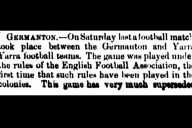It is 10am on a Saturday and I’ve arrived with a friend at a bustling café in inner Sydney, having driven up from Melbourne the day before.
Here I meet Trevor Thompson, an English expat, author of One Fantastic Goal: A Complete History of Football in Australia, and ABC journalist who has covered the game for decades. Casual as you like, he strolls into the café, orders breakfast and begins telling us everything he knows about football in Australia, right from the first kick-off.
Like many Australians, I once naively believed Australian football to be very young, born out of that famous penalty shootout to qualify for the 2006 World Cup. Others remember the days of post WWII migration or the National Soccer League (NSL) competition. Trevor, essentially a footballing encyclopaedia, is quick to assure me our history stretches much further than that.
“My contention is that outside of Britain, Australia has perhaps the longest record of playing organised football of any country in the world,” he says with great conviction.
“We probably started playing knockabout games in the 1870s. The famous game of 1880 that people commemorate is what I describe as the first properly documented game.
“Within 12 months there was a competition already going in Sydney. It spread around the country pretty comfortably.”
However, Trevor attributes post-WWII migration as the biggest shot in the arm for football in Australia, where a generation of new citizens brought along a fervent passion for the round ball with them.
“Migration was a complete revolution in the game. It provided players, administrators and fans.”
With a history dating back to the late 19th century and enjoying regular booms in popularity, it’s a curious phenomenon that football was swept under the Australian sporting rug for so long. Trevor concedes that constant episodes of inept administration, missed opportunities, and cultural intolerance all prevented football from embedding itself in the public mainstream.
Australian football’s great missed opportunity
“The biggest missed opportunity is an incredible episode that never gets talked about.”
“We look at Spain and France as these phenomenal footballing powers. But what were they like in those times? Australia could have been up there.
“Bohemians from Prague were one team that toured in Australia. Australian teams generally did well against them.”
Trevor says that it was on the back of the Bohemians tour that Australia had a grand plan to “undertake a tour of Europe and participate in the 1928 Olympics”, a huge chance to showcase itself to the world and raise the profile of the sport even further in Australia.
“Maurice Vandendriessche, a French international who also played in Sydney and Melbourne, was known to Robert Guérin, who established FIFA, and L’Équipe journalist Gabriel Hanot, who invented the competition now known as the European Champions League.”
“Vandendriessche organised games against European clubs, and Bohemians offered their stadium as the home base for the tour.”
But the plan was “scuppered” by a number of setbacks.
“The change to the rules of what constituted an amateur in 1927 meant that the British associations withdrew from FIFA altogether. Australia, not yet an independent member, had to withdraw through our association with England.”
“Our allegiance to British ideas, as opposed to more internationalist ideas, was crippling.”
But that was not the only factor hurting Australia, as people from within were actively “lobbying against any Australian involvement”.
“The AFL and rugby league did not want football having some kind of association with the Olympics. The Olympics were a huge deal in Australia.”
“Also, 1928 was the first semi-professional football competition in Australia. Clubs did not want their leading players away for the whole season.”
As it turned out, the 1928 Olympics became a stepping-stone for all nations involved to reach greater heights.
An all-expenses paid trip to the World Cup?
“At the 1928 Olympics, FIFA congress formally endorsed a proposal to stage a World Cup. If Australia had gone to the Olympics, they would have been invited, along with every other team, to participate at the World Cup.”
But the potential benefits would not have ended there. For Australia, who, “up until recently has always worried about what they can afford”, participation in the World Cup would have cost absolutely nothing.
“Uruguay, who got the World Cup gig, paid the costs of all participating teams. They covered for travel, accommodation and team allowances.”
“That was a gigantic opportunity we missed out on.”
Inept administration, which refused to grasp “the simple logic of promotion and relegation”, continued to blight the sport throughout post-war immigration.
“Migration did unite and divide. Vast amounts of conflicts eventually emerged.”
“A lot of the guys had no real clue about how to handle different situations. You had a boom in the game, loads of new teams, and great new skills visible.
“The people running football were assimilationists. When the new waves of immigrants established new clubs, you couldn’t get promoted to the top division because the association determined who would go. ‘Why don’t these guys just go and enrol in existing teams?’ was the logic of the day.”
Then, when Australia was re-admitted to FIFA in 1963, an opportunity arose to join the Asian confederation, which would have provided stronger pathways for competition and player development.
“The Asian football confederation in 1963 made overtures to Australia to join the federation, but were told, ‘no’.”
“Again, these were relatively small-minded officials who protected their own interests, rather than seeing the bigger picture.”
As a result, Australia was stuck in the backwaters of Oceania, of which one of the consequences were no direct qualifications to any World Cup.
“It was a problem that took us 30, 40 years to solve,” Trevor laments.
An ‘alien game’ with ‘alien people’
The constant shortcomings from within further hampered football’s standing in Australia, already detested by the wider public for being a perceived threat to established, ‘anglo’ sports.
“On one tour from an overseas team, Fitzroy FC (Australian Rules) complained about the use of an oval for this ‘alien game’ with ‘alien people’ using ‘Australian’ resources.”
Discrimination of this kind has been a prominent theme even to this day, which Trevor has archived thoroughly.
“I have an article from someone fairly prominent in Australian Rules circles, talking about how scandalous it was that the AFL and the Victorian government were going to cooperate with the Australian bid to host the World Cup, because that could only mean more kids playing football, and this was a disastrous idea.”
Despite the historical difficulties the sport has faced, Trevor is confident the sport’s current resurgence in popularity is one that can be sustained.
“I think it’s well placed now. We have a solid competition, proper commercial basis, good media attention, good footballers playing at good and safe venues and the possibilities of expansion, especially in Asia, are good.”
“Our future is intimately linked with Asia and a bigger and better A-League. When the Asian Champions League receives more traction in Australia, sponsors will love it.
“It’s not just a market with 20 million people. They can put [their brand] in front of hundreds of millions of people.
“We have no one to blame except ourselves if we can’t make the most of that opportunity.”

















All good but surely we can do away with the idea that the 1880 game is the “first properly documented game” see this http://neososmos.blogspot.com.au/2013/04/the-origins-of-association-football-in.html